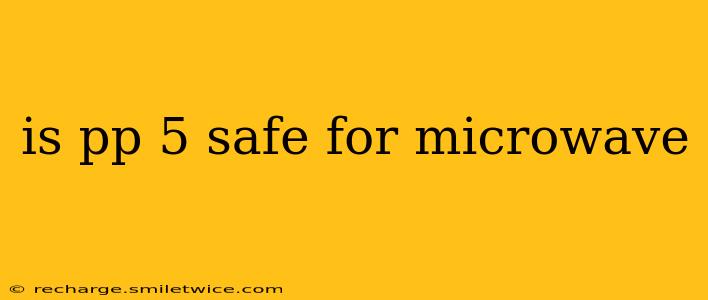The question of whether PP5 plastic is microwave-safe is a common one, and the answer isn't a simple yes or no. Understanding the nuances of plastic types and microwave safety is crucial for ensuring food safety and the longevity of your containers. This guide will delve into the specifics of PP5 plastic and its microwave suitability, addressing common concerns and providing practical advice.
What is PP5 Plastic?
PP5, or Polypropylene 5, is a type of thermoplastic polymer widely used in food packaging and containers. It's known for its durability, resistance to heat, and chemical inertness. However, the "microwave-safe" label isn't universally applied to all PP5 plastics. The key lies in the specific additives and manufacturing processes used.
Is All PP5 Microwave Safe?
No. While PP5 can be microwave-safe, it's not guaranteed. Some PP5 plastics contain additives that may leach into food when heated in a microwave. Furthermore, the quality of the manufacturing process plays a significant role. A poorly constructed PP5 container might warp or melt under microwave heat, posing a safety risk.
How Can I Tell if My PP5 Container is Microwave Safe?
Look for the following indicators:
- Microwave-safe symbol: The most reliable indicator is a clearly marked microwave-safe symbol on the container. This symbol usually depicts a microwave oven graphic.
- Manufacturer's instructions: Always check the manufacturer's label or instructions. They will explicitly state whether the container is suitable for microwave use.
- Material quality: High-quality PP5 containers are typically thicker, more durable, and less likely to warp or melt in the microwave. Avoid containers that feel flimsy or show signs of damage.
What Happens if I Use a Non-Microwave-Safe PP5 Container?
Using a non-microwave-safe PP5 container in the microwave may lead to several potential problems:
- Chemical leaching: Certain additives in the plastic can leach into your food when heated, potentially exposing you to harmful chemicals.
- Melting or warping: The container could melt, warp, or crack, contaminating your food and potentially damaging your microwave.
- Food contamination: If the container melts or cracks, your food will become contaminated and unsafe to eat.
Can I Heat PP5 in the Microwave if it Doesn't Have a Microwave-Safe Symbol?
No. It's best to err on the side of caution. If a PP5 container doesn't clearly state that it's microwave-safe, avoid using it in the microwave. There are many other microwave-safe alternatives available.
What are Some Microwave-Safe Alternatives to PP5?
Several other materials are explicitly designed for microwave use:
- Glass: Glass containers are generally safe for microwave use.
- Microwave-safe plastic: Look for containers clearly labeled as "microwave-safe."
- Silicone: Silicone containers are often microwave-safe and flexible.
- Ceramic: Ceramic dishes are usually suitable for microwave use.
Always check the manufacturer's instructions for any container before using it in the microwave.
Is it Safe to Reheat Food in PP5 Containers?
Only if the container is specifically labeled as microwave-safe. Even then, it's advisable to avoid reheating for extended periods to minimize the risk of any potential leaching.
Remember, prioritizing food safety is crucial. When in doubt, always choose a container that explicitly states it's microwave-safe. By carefully selecting appropriate containers and following these guidelines, you can safely and efficiently use your microwave while protecting your health and the longevity of your kitchenware.
